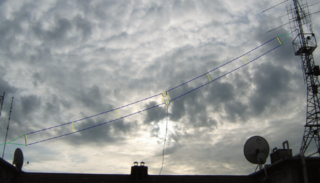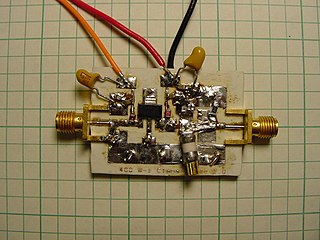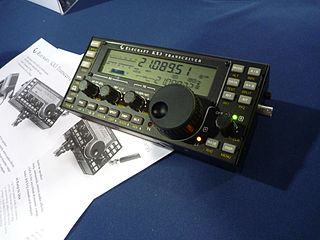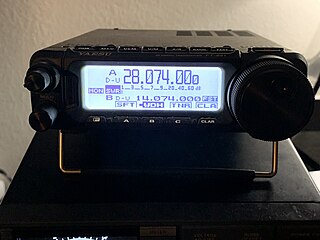
Software-defined radio (SDR) is a radio communication system where components that conventionally have been implemented in analog hardware are instead implemented by means of software on a computer or embedded system. While the concept of SDR is not new, the rapidly evolving capabilities of digital electronics render practical many processes which were once only theoretically possible.

The Tilted Terminated Folded Dipole or Balanced Termination, Folded Dipole (BTFD) - also known as W3HH antenna - is a general-purpose shortwave antenna developed in the late 1940s by the United States Navy. It performs reasonably well over a broad frequency range, without marked dead spots in terms of either frequency, direction, or angle of radiation above the horizon.
The American Radio Relay League (ARRL) is the largest membership association of amateur radio enthusiasts in the United States. ARRL is a non-profit organization, and was co-founded on April 6, 1914, by Hiram Percy Maxim and Clarence D. Tuska of Hartford, Connecticut. The ARRL represents the interests of amateur radio operators before federal regulatory bodies, provides technical advice and assistance to amateur radio enthusiasts, supports a number of educational programs and sponsors emergency communications service throughout the country. The ARRL has approximately 161,000 members. In addition to members in the US, the organization claims over 7,000 members in other countries. The ARRL publishes many books and a monthly membership journal called QST.

An S meter is an indicator often provided on communications receivers, such as amateur radio or shortwave broadcast receivers. The scale markings are derived from a system of reporting signal strength from S1 to S9 as part of the R-S-T system. The term S unit refers to the amount of signal strength required to move an S meter indication from one marking to the next.

Contesting is a competitive activity pursued by amateur radio operators. In a contest, an amateur radio station, which may be operated by an individual or a team, seeks to contact as many other amateur radio stations as possible in a given period of time and exchange information. Rules for each competition define the amateur radio bands, the mode of communication that may be used, and the kind of information that must be exchanged. The contacts made during the contest contribute to a score by which stations are ranked. Contest sponsors publish the results in magazines and on web sites.
The R. L. Drake Company is a manufacturer of electronic communications equipment located in Springboro, Ohio. It is also known for its line of equipment for amateur radio and shortwave listening, built in the 1950s through the 1980s. The company operates as a separate entity owned by Blonder Tongue Laboratories, Inc.

Contest logging software refers to specialized computer software programs designed for use by competitors in amateur radio contesting. Most contest logging software is written by individual programmers who are active radio contesters.

The AN/ARC-5 Command Radio Set is a series of radio receivers, transmitters, and accessories carried aboard U.S. Navy aircraft during World War II and for some years afterward. It is described as "a complete multi-channel radio transmitting and receiving set providing communication and navigation facilities for aircraft. The LF-MF-HF components are designed to transmit and receive voice, tone-modulated, and continuous wave (cw) signals." Its flexible design provided AM radiotelephone voice communication and Modulated continuous wave (MCW) and Continuous wave (CW) Morse code modes, all of which are typical capabilities in other Navy aircraft communication sets of the period. It was an improvement of the Navy's ARA/ATA command set. Similar units designated SCR-274-N were used in U.S. Army aircraft. The Army set is based on the ARA/ATA, not the later AN/ARC-5. The ARA/ATA and SCR-274-N series are informally referred to as "ARC-5", despite small differences that render all three series incompatible. Like the AN/ARC-5, the ARA/ATA and SCR-274-N had AM voice communication and two-way MCW and CW Morse code capability.
William Ittner Orr (1919–2001) was an engineer, educator, communicator, and ham radio operator. He was the American author of numerous amateur radio and radio engineering texts. He is best known as the author of The W6SAI Antenna Handbook and fondly remembered for the 1959 Radio Handbook.

A quad antenna is a type of directional wire radio antenna used on the HF and VHF bands. Like a Yagi–Uda antenna ("Yagi"), a quad consists of a driven element and one or more parasitic elements; however in a quad, each of these elements is a loop antenna, which may be square, round, or some other shape. It is used by radio amateurs on the HF and VHF amateur bands.

A radio-frequency power amplifier is a type of electronic amplifier that converts a low-power radio-frequency (RF) signal into a higher-power signal. Typically, RF power amplifiers are used in the final stage of a radio transmitter, their output driving the antenna. Design goals often include gain, power output, bandwidth, power efficiency, linearity, input and output impedance matching, and heat dissipation.

Cary Audio Design is a company founded in May 1989 which originally designed and manufactured vacuum tube audio amplifiers. Since the mid-1990s they have expanded into the home theater market, producing DVD players and surround sound processors in addition to their original vacuum tube designs.

The Moxon antenna or Moxon rectangle is a simple and mechanically rugged two-element parasitic array, single-frequency antenna. It takes its name from the amateur radio operator and antenna handbook author Les Moxon.
Barrett Communications is a specialist manufacturer and supplier of commercial high frequency (HF), tactical HF and very high frequency (VHF) communications equipment. Its head office for design and manufacturing is located in Perth, Western Australia. Barrett was acquired by Motorola Solutions in 2022.
The Yaesu VX series is a line of two sequences of compact amateur radio handheld transceivers produced by Yaesu. There is a line of ultra-compact lower-power dual-band transceivers that started with the VX-1R and was later updated with the VX-2R and VX-3R. There is also a line of 5W tri-band transceivers that started with the VX-5R and was later updated with the VX-6R, VX-7R and VX-8R.

Elecraft, Inc. is an American manufacturer of amateur radio ("ham") equipment and kits, based in Watsonville, California. It was founded in 1998 by Wayne Burdick and Eric Swartz. The company's first product was the K2 transceiver; first prototyped in October 1997.
Martin F. Jue is an American business personality, inventor and founder/owner of several companies, including MFJ Enterprises, Hy-Gain, Cushcraft, Ameritron, Vectronics and others, all of which manufacture products for the amateur radio industry. He holds numerous patents on specialized technology, especially in the area of T network field tuners.
Rig Expert Ukraine Ltd is a manufacturer of ham and PMR Two-way radio RF antenna analysis and antenna tuning equipment. The company was founded in 2003 and is headquartered in Kyiv, Ukraine.

The Yaesu FT-891 is a HF and 6 meters all mode mobile amateur radio transceiver. The FT-891 was first announced to the public by Yaesu at the 2016 Dayton Hamvention. The radio has 100 watts output on CW, SSB, and FM modulations and 25 watts of output in AM. As a mobile transceiver the FT-891 is well suited for mobile installation in vehicles, and weighing less than 5 pounds it is often used for field activations such as Summits On The Air and Parks On The Air. The radio has been praised for its noise reduction and sensitive receiver. Common criticisms of the radio include its many menus that are difficult to navigate with its small screen, the lack of VHF/UHF capabilities, and lack of an internal antenna tuner. Although the radio lacks an internal sound card it still has input and output jacks for audio and be controlled over a USB cable allowing the radio to use digital modes such as WinLink, PSK31 and FT8.












